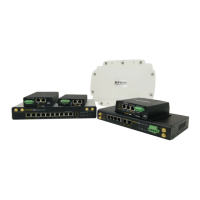except for those on the Exempted User Groups or Exempted Subnets defined below.
If "foobar.com" is entered, any web site with a host name ending in foobar.com will be blocked,
e.g. www.foobar.com, foobar.com, etc. However, "myfoobar.com" will not be blocked.
You may enter the wild card ".*" at the end of a domain name to block any web site with a host
name having the domain name in the middle. If you enter "foobar.*", then "www.foobar.com",
"www.foobar.co.jp", or "foobar.co.uk" will be blocked. Placing the wild card in any other position
is not supported.
The device will inspect and look for blocked domain names on all HTTP and HTTPS traffic.
21.2.3 Customized Domains
Enter an appropriate website address, and the Pepwave MAX will block and disallow
LAN/PPTP/SpeedFusionTM peer clients to access these websites. Exceptions can be added
using the instructions in Sections 20.1.3.2 and 20.1.3.3.
You may enter the wild card ".*" at the end of a domain name to block any web site with a host
name having the domain name in the middle. For example, If you enter "foobar.*," then
"www.foobar.com," "www.foobar.co.jp," or "foobar.co.uk" will be blocked. Placing the wild card in
any other position is not supported.
The Pepwave MAX will inspect and look for blocked domain names on all HTTP traffic. Secure
web (HTTPS) traffic is not supported.
21.2.4 Exempted User Groups
Check and select pre-defined user group(s) who can be exempted from the access blocking
rules. User groups can be defined at QoS>User Groups section. Please refer to Section 17.1
for details.
21.2.5 Exempted Subnets
With the subnet defined in the field, clients on the particular subnet(s) can be exempted from the
access blocking rules.
21.2.6 URL Logging
Click enable , and the enter the ip address and port (if applicable) where your remote syslog
server is located.

